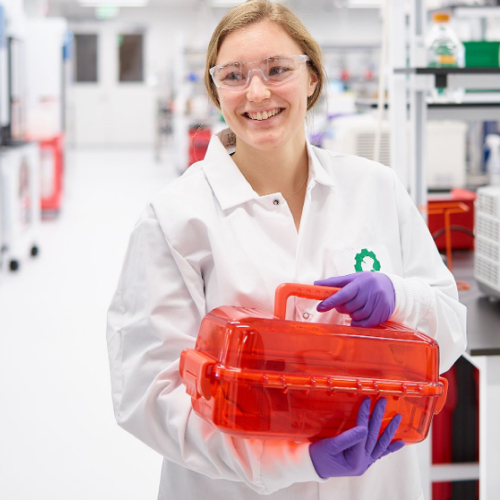The Residency is Virtual
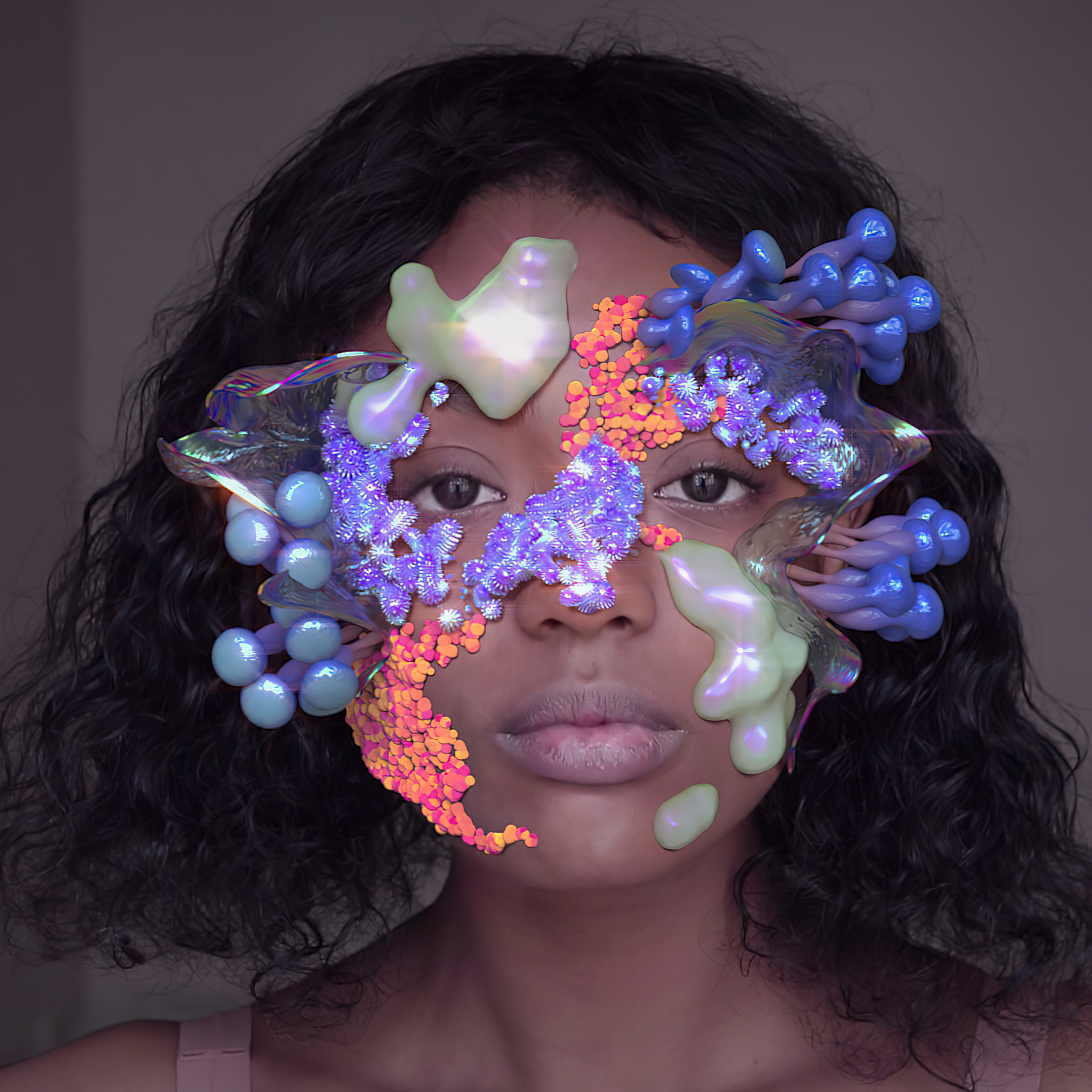
Over the past few years we have developed a body of work exploring alternative relationships between living organisms and data, most notably through our research initiative Grow Your Own Cloud. We were delighted to be awarded the Ginkgo Creative residency as it was something we have aspired to, and with the theme for the residency being ‘Skin’, we initially envisaged exploring ways in which skin could become a site for novel data interactions.
Meanwhile a global pandemic began to brew. The cities we were in at the time (Paris and Warsaw) went into lockdown. The parks were bolted shut. The restaurant boarded up. Alone in the city, the lack of physical contact with other people became clearly noticeable. Isolation brought a growing sense of touch deprivation. Meanwhile things became ever more screen based. Normal life became Zoom life. All of this meant the residency which usually involves creatives spending time at the famous Ginkgo lab would instead take place online. The residency was going to be a residency of firsts. We were the first duo. We would be the first virtual residents. So what is the reality of a remote residency?
The remote residency began with us in France and Poland connecting with the Ginkgo Residency team – Christina Agapakis, Josh Dunn, Grace Chuang and Kit McDonnell in the US, and Natsai Audrey Chieza in the UK. Connections were facilitated through Zoom, Slack and Slides, digital staples of the pandemic, but the nature of embarking on fresh and creative research through these channels gave this process a different flavour. Our research scope centred on better understanding aspects of synthetic biology, exploring the science of skins, especially the skin microbiome and delving into interspecies communication. Zoom became a highly efficient research resource, allowing us to instantly connect with microbiologists, mammalian engineers, organism designers, founders, software designers, DNA encoding specialists, and even designers at Ginkgo.
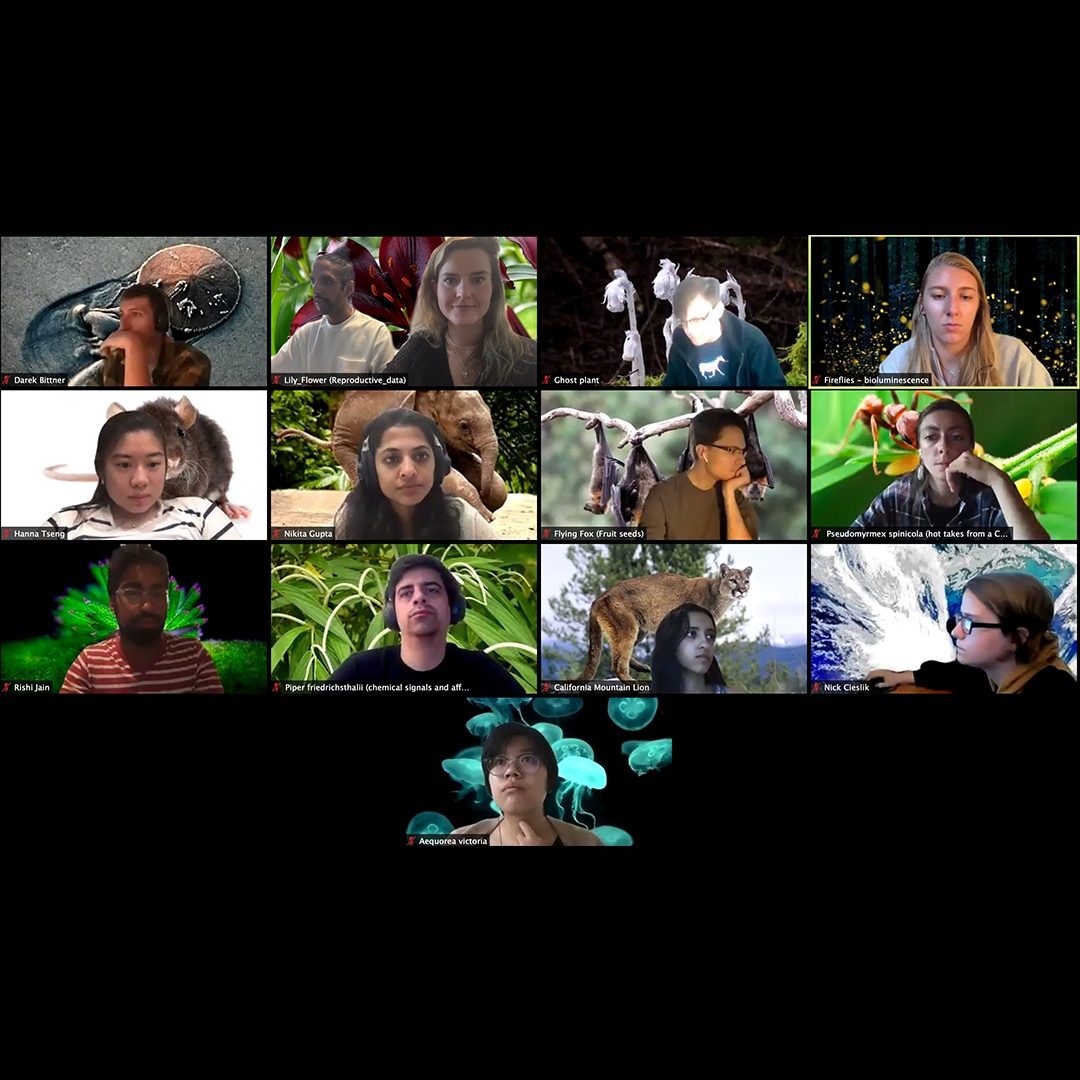
We were able to indulge in conversations about the nuance of viruses, biological scales, genetic modification, engineering nature and alternative biological futures. Our catch-ups with the Ginkgo residency team were always full of wonderful insights, references and critical feedback. Our weekly calls with Josh in particular were a highlight, giving us a chance to dig into big questions around synthetic biology. It was an interesting feeling to essentially have a direct line to so much human knowledge that thanks to online tools we could literally download. A seemingly endless fountain of inspiration and ideas, and we leave the residency with a multitude of potential ideas for future works.
With a virtual residency, the sense of space takes on a decentralised character, existing in multiple places at once. There is a trade-off at play, a lack of grounding which in turn creates the sensation of an almost limitless span. In the circumstances, it became very natural for our research net to be cast wide. Outside of the Ginkgo community, we spoke to an array of experts including 3D artists, dancers, choreographers, experience creators and permaculture practitioners. As restrictions eased in Europe this led us to take a field trip to Farma in Sweden to experiment with some of our research in the forests amongst our guides Henno and Henriette. Perhaps had the residency taken place in its normal format we would not have had the impulse to bring in this range of voices and views.
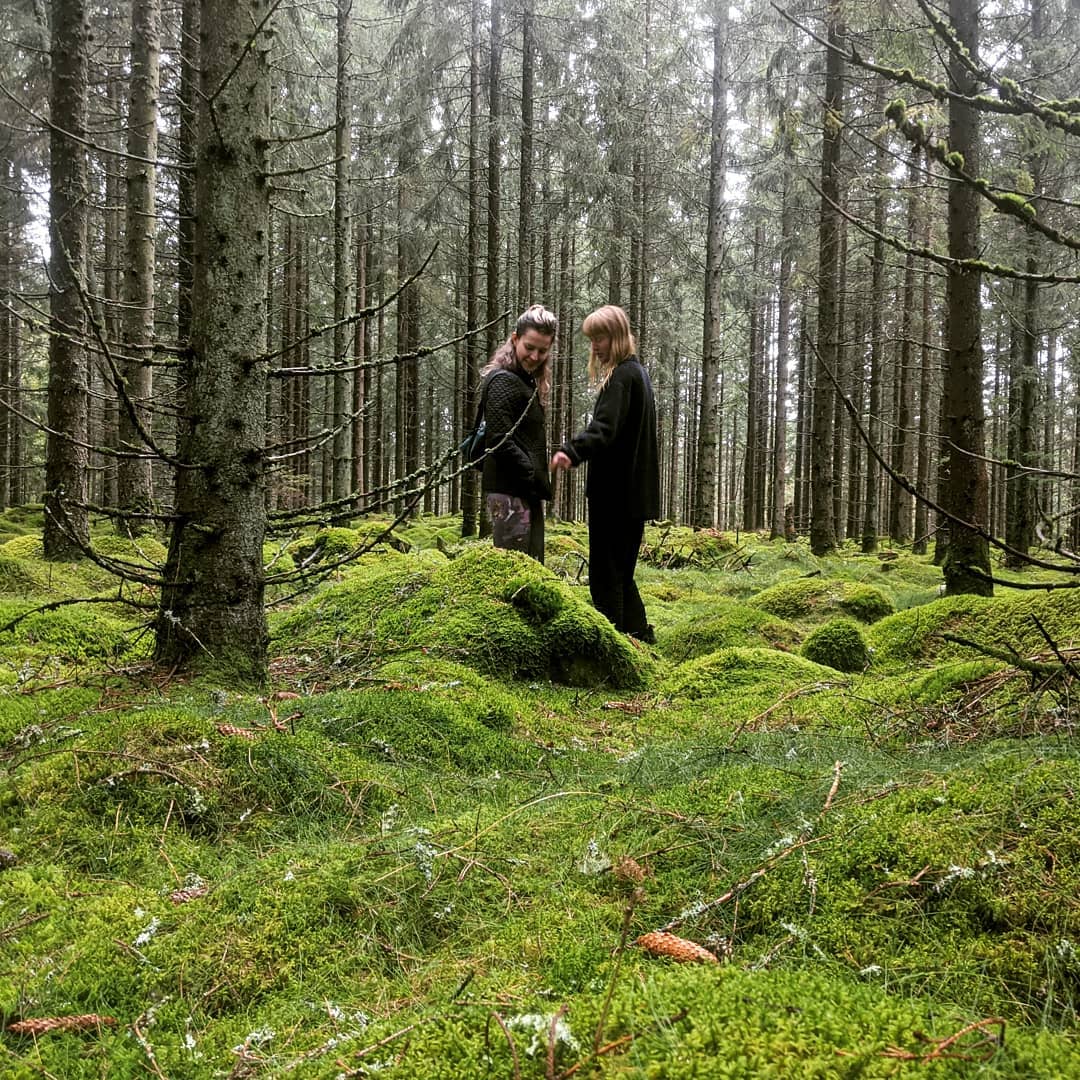
In previous projects and residencies working physically was a given, it helped us to not only express ideas, but to display them and allow others to follow our process and progress. We used digital boards with varying degrees of success to replicate this. While being digital natives, the creative process we follow as a duo perhaps was not conducive to a pure digital collaboration. We could see the benefits whenever tasks were systematised or routine, however in any instance requiring a deeper collaboration or expansive, creative thinking, the tools and process fell short. Another limiting factor of course was our physical separation from the activities at Ginkgo. As people we thrive on connection and collaboration, and while the digital world offers alternatives with certain benefits, our experience was that it was harder to feel close to the action, to the science. We were able to dive into theory, but moving towards the practical from a non-theoretical point of view was a challenge.
As has been the case for many, the sometimes endless hours on Zoom took their toll. We quickly learned that in this model of working and collaboration we had to be gentler on ourselves, taking care to be away from the screen, even while knowing we had a limited time to connect with each other and the Ginkgo universe. Accepting the situation as it was, helped us to redefine and manage our expectations and to see elements of our research as experiments within experiments. We conducted workshops with the Ginkgo team through digital channels bringing them into our ideation process, immersing them in our research contexts and challenging them to collaborate across fields. Ultimately this sense of social isolation, physical separation and virtual connection proved to be a strong source of inspiration for the direction of our research project.
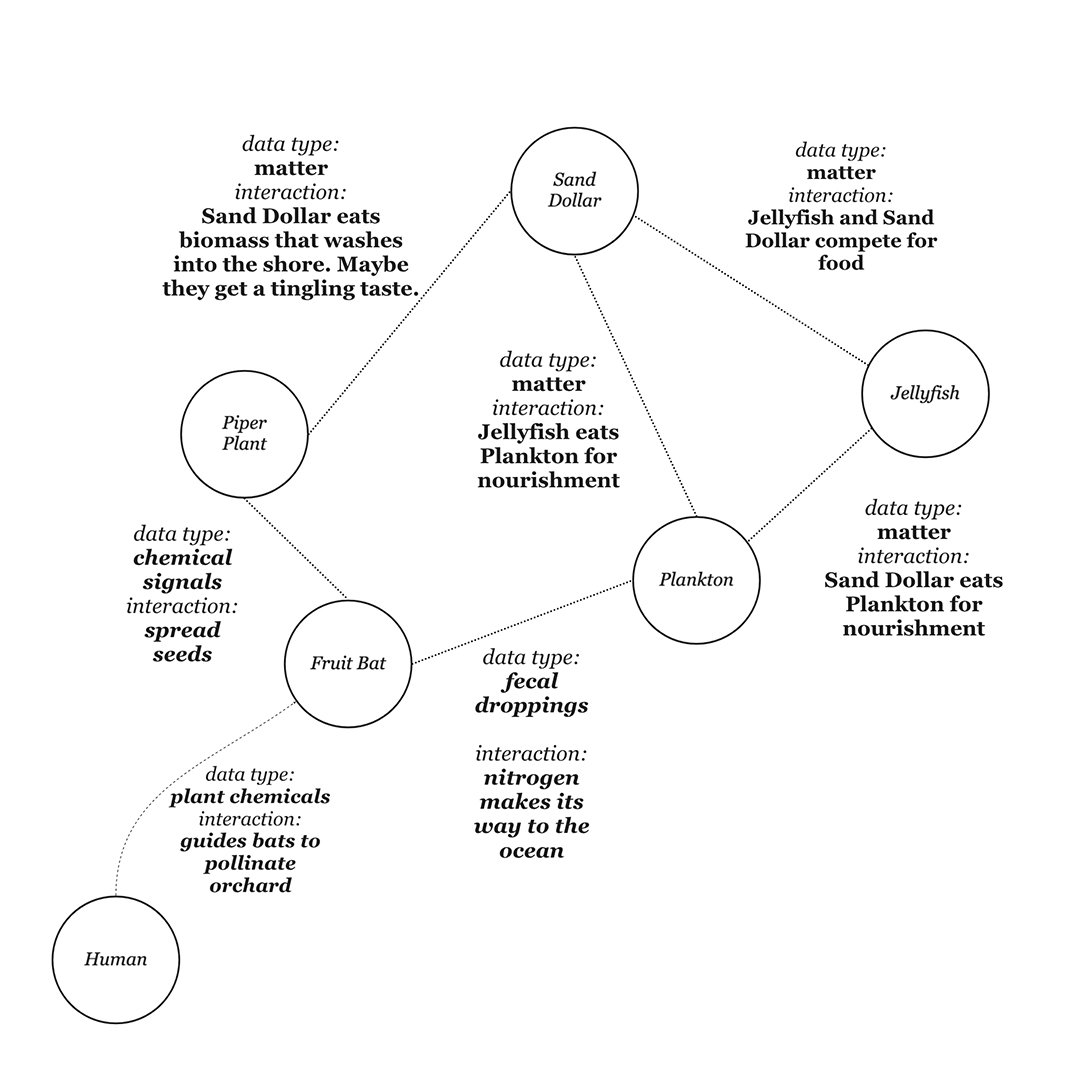
Unheard, Unseen and Undetected
‘We change through the collaborations both within and across species. The important stuff for life on earth happens in those transformations, not in the decision trees of self contained individuals’ – Anna Tsing
During our interview for the residency we had created a speculative data mapping for the types of data we might encounter through a residency exploring interactions between data and skin. Within this map was the term ‘Interspecies Gossip’, which seemed to resonate with everyone conceptually. To us this term was originally not particularly related to the pandemic, rather it referred to the interconnectedness of things, living and inorganic, that we had so often theorised around through our work on Grow Your Own Cloud, inspired by the writings of people like Ursula K. Le Guin, Timothy Morton and Anna Tsing.
Everything is connected. All the interactions are interwoven. All the pieces should fit. Gossip is what holds it all together. Interspecies Gossip was a guiding metaphor that describes the holistic communication occurring and diffusing in living systems, across scales, temporalities, geographies, and between species. Our desire was to create ways for human beings to get back in touch with the ‘gossip’ in natural systems, working with skin as a native technology. We wanted to imagine ways in which we might facilitate communication between species and natural systems, and allow human beings to once again be part of the gossip ecosystem within the biological cloud.
As a duo, we have often framed our research around a question – What will it take for human beings to once again see themselves as part of nature?’ During the residency we continued to approach this question, by seeking to establish strategies for humans to encounter a seemingly hidden world, not as a master, guest, host or spectator, but as an equal participant amongst other beings. Through what mechanisms can we as human beings step back into the gossip that for the most part goes unseen, unheard and undetected?
Our research approach is centred on exploring values and needs that include both the human and nonhuman. We wanted to continue to follow a sense of responsibility and acknowledgment of the multifaceted, nuanced world of living systems. Neither romanticising it, nor sensationalising it, rather placing it in a relatable, even mundane light. With Ginkgo largely focusing on the micro-world, we saw opportunities to bring people into contact with a microbial ecosystem that they are currently fearful of, showcasing how the distances between threat and benefit are often razor thin and highly dependent on perception. With a research topic that was so ambitious in scope, it was vital to break it down into components. As a result we split our investigation into streams of research; skins, home, nonhumans and gossip, that combined to help form the eventual body of work that we now call Interspecies Gossip.
Skin as an Interface
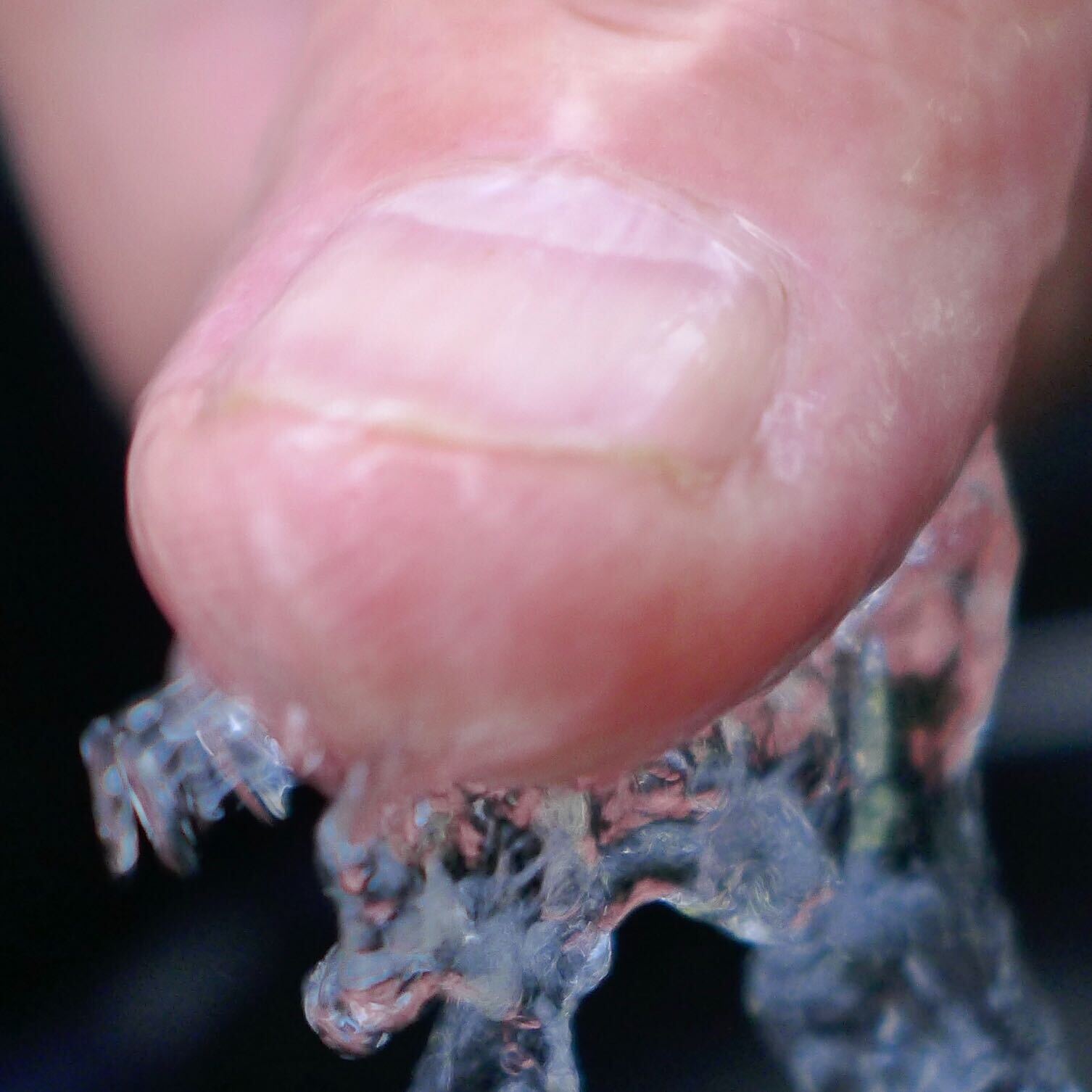
What even is a skin? Skins were a topic and material we had thus far not researched and the beginning of the residency was filled with curiosity about what we might discover. With a vast scope of possible skins to think about; animal skins, vegetable skins, architectural skins and so on, we made the decision early in our process to focus on human skin. This felt appropriate at a time where two emergencies were dominating much of the discourse, particularly in Europe and North America: the emergent COVID-19 pandemic and ongoing systemic racism, which may be characterized as an epidemic with regards to the mistreatment and deaths of Black people in particular, as well as indigenous people and people of colour. With interpersonal contact restrictions, arising as a result of the COVID-19 virus pandemic, we had an urge to develop ways for people to get back in touch with their bodies and skin. Working with the true diversity of skin was also vital, to counterpoint, unlearn, rethink and reframe systems of colonial power, visions and norms, particularly in the fields of biodesign and bioart, which skew highly towards white skin and pink flesh.
From the outset we were looking for ideas on how skin might facilitate new lines of data exchange and interaction between species. We met with Shawdee and Elie, mammalian engineers at Ginkgo, with whom we spoke about engineering skins, growing skins and the skin’s role as a barrier. This sparked more conversations about the use of terms like barrier that relate so strongly to notions of defence. This theme continued through our conversations with Patrick Boyle, head of codebase, as we started to imagine new metaphors. Could we, rather than thinking of war as a metaphor, start to think about communication? Could skin be seen as a habitat, a bridge, an interface?
Our guide to the world of skin throughout the residency was Jasmina Aganovic. We met regularly with Jasmina, often coming with a list of questions that she would devour, connecting dots while sharing knowledge and anecdotes with us. In our first meeting with Jasmina she told us about her views on the skin microbiome, and a phrase that would become central to our research; the skin microbiome as the “eyes and ears”. She told us of her experiences developing Mother Dirt as a response to the way modern cosmetics have ‘blinded’ the skin. This idea of a dulling of the senses really spoke to us. Could we find ways to reawaken the skin, drawing attention to the skin microbiome? The skin microbiome as Jasmina described it, could also be seen as a manufacturing site, giving us a sense of a thriving, busy community of microorganisms working together. It was a powerful figurative image. We could almost start to feel it.
By getting back in touch, we use skin as a tactile instrument to understand and embody the non-codified, non-binary data that exists within, amongst and across species. To explore these notions further we began working with performers and dancers, in particular Marianna Minasova, a choreographer based in Copenhagen. With Marianna we discussed how consent is established in bodily practices and how this might extend beyond the human. We theorized and speculated on how the skin might be transformed from a passive site to an active site of communication through movement, touch and rituals.
Life at Home
Our research context became the space we used most—the home. The place inhabited by people quarantined, spending increasing amounts of time due to the ongoing COVID-19 pandemic. This was an important decision and was a natural way to ground our research and creative direction. We had seen Ginkgo’s resident yeast expert Sudeep go viral prior to starting the residency, with his marvellous guide to home culturing. It got us thinking about the types of new rituals people were exploring in the home, and especially about how the organisms that live with us at home can be part of those rituals.
The new rituals of the pandemic were shared and spread organically through social media with platforms like TikTok and Twitter feeding our need for connection, social validation and entertainment. It seemed as if all roads led back to the screen. Our own personal screen fatigue at this point inspired us to situate our work in that world, using and appropriating aesthetics, but somehow taking the spirit to an offline format. Yet beyond screen fatigue, the escape and fun that these platforms represented was inspiring to us. With many people stuck at home, could our research help provide some magic and fantasy through the microbial cloud?
To explore the world of microscopic life at home, we read Never Home Alone by Rob Dunn. This was an instant breakthrough – to comprehend that while we might be home alone, we are never home alone. The book explores some of the species and ecosystems with whom we cohabit. What struck us was that Rob seemed to be asking the same fundamental questions we have been asking—why do we continue to see ourselves as separate from nature? What was intriguing in Rob’s work was that he was proving through science and demonstrating through science communication how flawed that feeling is. We simply, due perhaps to our size and senses, overlook what is right in front of us. Or sometimes underneath us, above us and on us.
The human senses are developed to sense at a particular scale; things which are too small or too large fall outside of our focus leaving eyes, ears, noses and skin oblivious. Inspired by Robin Wall Kimmerer’s book Braiding Sweetgrass we begin to wonder that with a multitude of organisms interacting across scales and genetic frontiers, can there truly be a universal language, perhaps of chemicals, that underpins everything, or are we all simply existing in a series of translations? Can we establish ways to be native to our homes, by getting back in touch with the tacit knowledge that natural systems hold?
Gossiping Nonhumans
The word gossip has many meanings in the human context. It typically connotes scandalous secrets and illicit tales passing from ear to ear. Yet gossip is so much more than that. At its essence it is simply a way to share stories and connect. During the pandemic in a world of screen based connection, algorithmic feeds and glitchy audio, the lack of space for serendipity, for mishaps, mischief, and ultimately for gossip was evident.
As so often in times of lack, other options emerged. Entertainment sought to fill the void, but the social bonds that only gossip can create, when practised healthily, are not so easy to replace. More than anything, tales of ‘she said’, ‘they did’ and ‘you’ll never guess what’ strengthen our social connections, a nourishing almost ritualistic practice that gives us a little boost. Perhaps then instead of peeking through curtains, binging on 90s re-runs, developing a taste for so-called conspiracy theories, or just being totally fed up with a situation largely out of our individual control, we can look to gossip as a way to do what it does best – connect. But how can we get our fix of gossip at a moment where moments of magic are scarce and other human beings are off limits? How about getting in touch with other species, an unlikely set of new tale tellers, rumourmongers and eavesdroppers.
In the spirit of reaching out during the pandemic, we decided to write to Rob and let him know how much his book had inspired us. Rob got back to us almost immediately and we began having wonderful chats discussing our ideas around Interspecies Gossip, connecting our musings with his scientific knowledge. We began to see the home as a nest of nonhuman gossip that, were it audible, would be deafening. The home was repositioned as a context in which organisms from diverse geographies and temporalities converge in a multitude of ecosystems.
While we think of gossip as a strictly human affair, the microbes do love to gossip. They share stories about their past. Their love lives. Their darkest fears. Their hopes. They even gossip about the humans who live amongst them. They use various languages and dialects ranging from chemical signatures, alluring odours and inaudible audio. Their conversations diffuse across different perceptions of reality, space and time. They work with evolutionary senses, which though seemingly familiar, are tuned to hear, smell, see, taste, and feel in ways which bend human conceptions.
Each organism has a unique story to tell of where it has been, who it has met, and what it has been through. Through our conversations with Rob, we created a cast of species to encounter within Interspecies Gossip; Springtails eagerly hopping around, Mycobacterium vaccae sharing good vibes, Stachybotrys moulds waiting for the flood that never comes and many more. We mapped organisms to different parts of the home, to critical sites and issues, as well as their interwoven and interconnected relationships. Allowing the tone of gossip to guide our approach, we projected accessible and relatable characters and personalities onto the nonhuman beings. This was a deliberate choice, as rather than seeking new ways of discussing the nonhuman world, it was more important for us that a potential audience could access and approach this world.
Interspecies Gossip
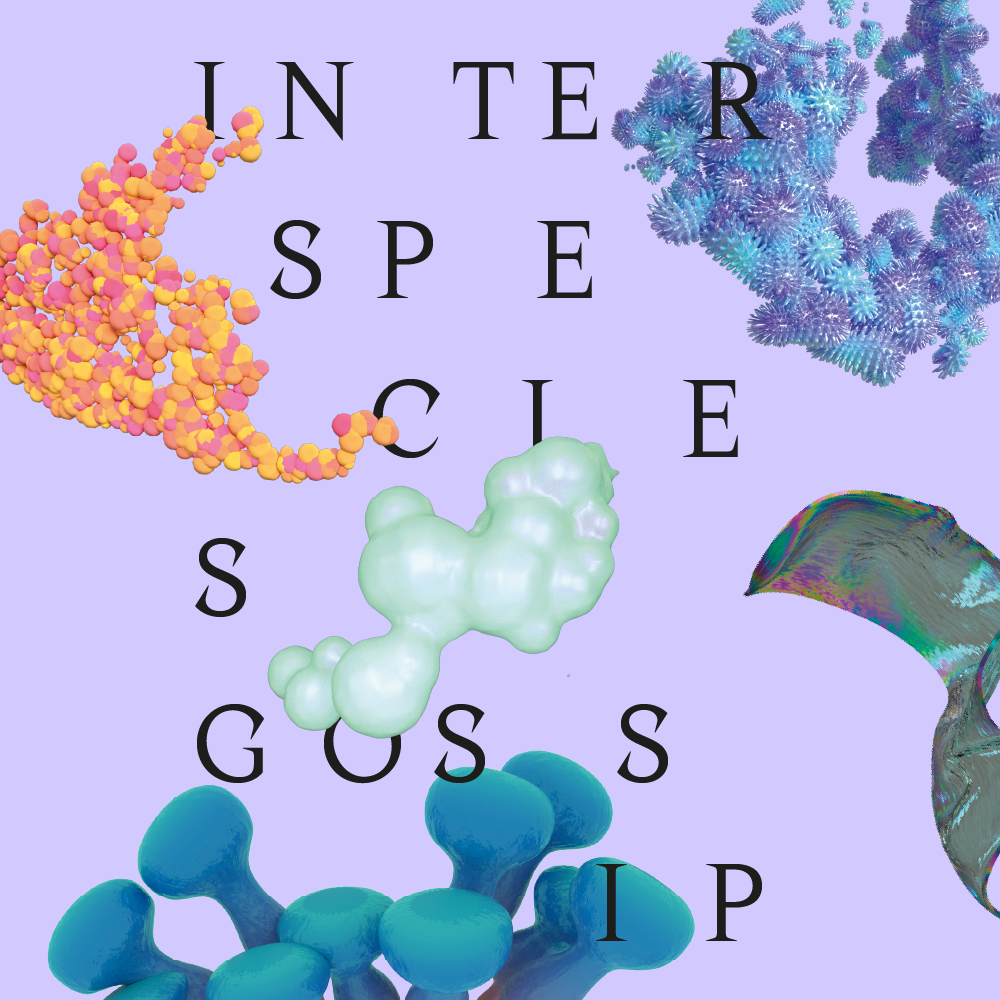
Interspecies gossip is a collection of stories and a guide to a new practice, that might once again connect human beings with the nonhuman kin we live alongside. In equal parts science, fiction and speculative fantasy, it reveals the conversations within, between and amongst communities of species that go unheard, unseen and undetected by human beings in their own homes. By following the guide, you embark on a journey encountering chatty viruses, bored bacteria, intoxicated butterflies and heartbroken plants, accompanied by bodily rituals designed to help you get in touch with the nature of the home. Through Interspecies Gossip, we give a voice to the voiceless, create a space for reconnection and allow ourselves to indulge in some subversive fun.
With people suffering from social isolation, touch deprivation, and increasing reliance on the digital cloud for connection, Interspecies Gossip presents an alternative hedonism, inviting you to embrace the nonhuman world, using your skin as a technology to connect to the microbial cloud. Through this work we invite you to explore the home in a new way, encountering the microbial cloud with the native technology of your skin. The skin’s true nature is revealed and its full potential harnessed. Rather than being seen as a barrier or as a site to be cleansed of microbes, we offer a practice which emphasizes the active skin-microbiome, a living interface. The eyes and ears of the body. A point of connection to another world.
You and the Home you inhabit are inextricably linked to Interspecies Gossip. The Home is transformed into a sensorial playground which your body knows how to feel. The smells that emanate from underneath your pillow are legions of bacteria, fungi and protozoa gossiping about who’s in and who’s out. The slippery feeling in your shower is a rich community of organisms, a biofilm, inviting you and your microbial cloud to dance, while worrying about what might happen after the inevitable fall from grace.
By getting in touch with Interspecies Gossip, we as humans, being, get in touch with the knowledge of living systems which we mistakenly consider only exist in exotic far-flung places. We start to understand the interconnectedness of things, how interactions extend from the microscopic to planetary scale, even within the microcosm that is the home. We attune our senses to the networks of non-binary data exchange that spread and diffuse between different beings, across linguistic chasms, throughout the living world. Above all we start to reconnect with the natural world, a world which humans have attempted (unsuccessfully) to extricate and separate themselves from. We do all this from the confines and comforts of the habitat known as the home.
The core of the work is an interactive book, designed and developed in collaboration with Henriette Kruse and Ines Alpha, which progresses through 3 chapters: Initiation, Growth, and Immersion.
In Chapter 1 – Initiation, the reader is invited to work with the skin as a performative site and develop bodily practices to touch the microbial gossip at home. We establish modes of consent, and begin exploring life at home through a series of stories, which reveal the hidden voices of the beings that live at home through chatty tales of gossip.

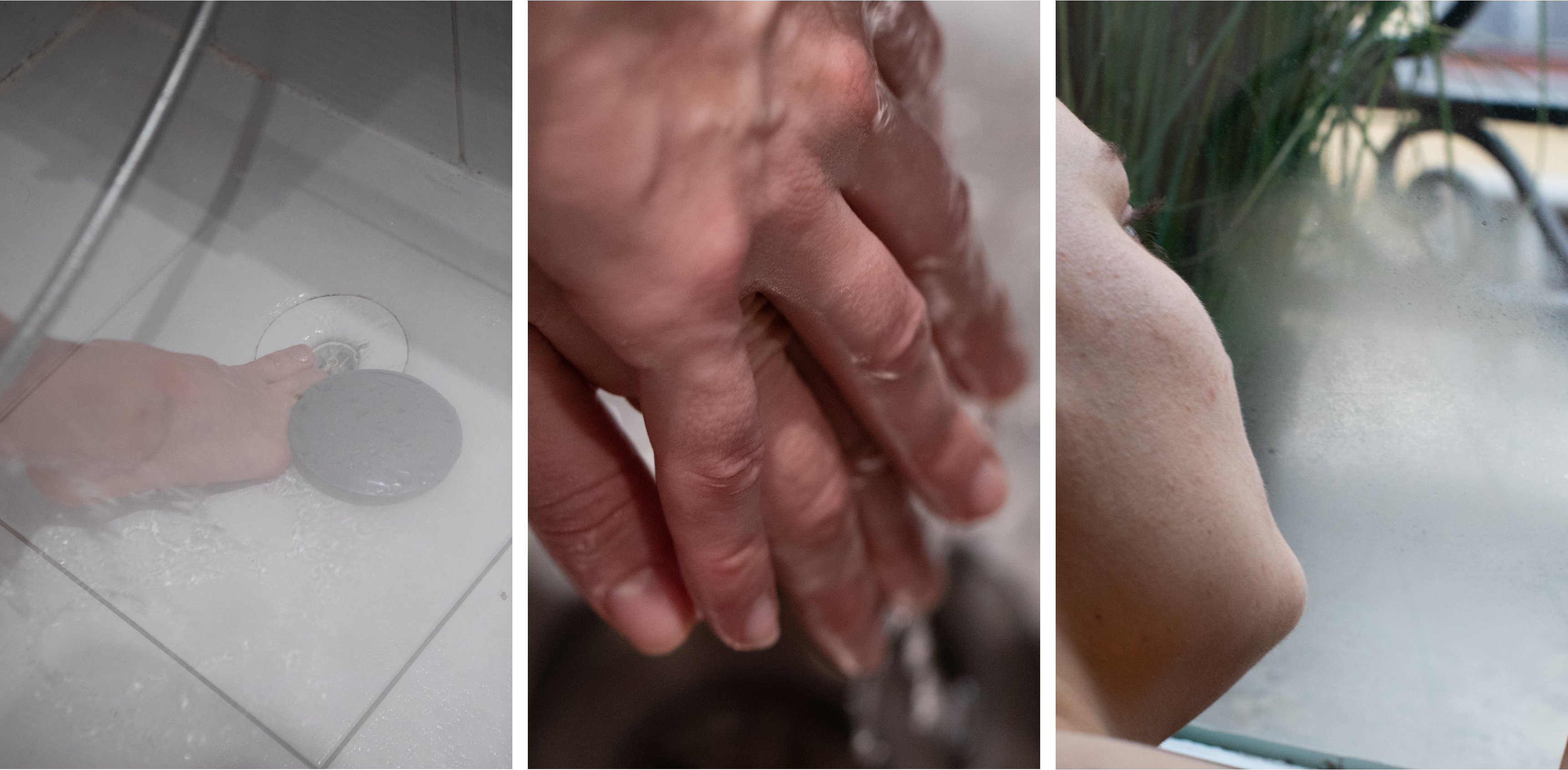
The tales of Gossip in Chapter 1 start with ‘Gossip About You’ which as the name suggests are stories of other beings gossiping about you, the human within the home. The second section of Chapter 1 is entitled ‘Gossip between the Species’ which delves deeper into the relationships the nonhuman species have with each other.
Further on this Chapter includes a set of stories exploring how gossip can travel through space and time. Each story is accompanied by a bodily ritual, which presents a method for the reader to literally get back in touch with other beings. Working with Marianna, we developed these analog rituals for readers to engage in our science fantasy and follow in order to make contact with the nonhuman beings. The rituals are documented through photography and video, shot in vertical formats reminiscent of the aesthetics of Tik Tok and Instagram.
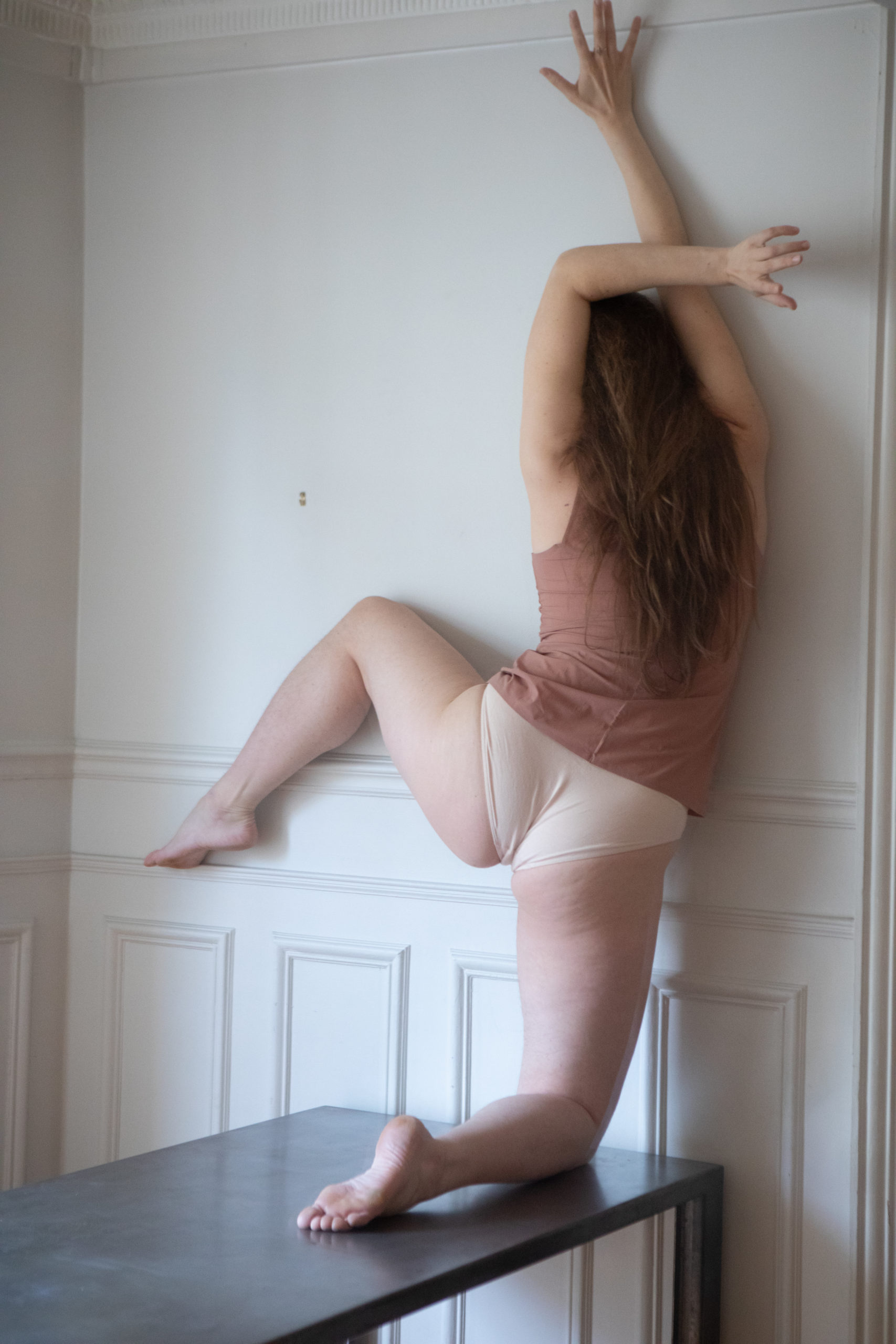
Objects of Attraction
Chapter 2 is all about growing. Growing interfaces that are designed to attract more gossip to the home and body. We called these ‘Objects of Attraction’. These living objects attract and rewild the home. They can be applied to skin to create an attraction layer and can be mated to create new variants.
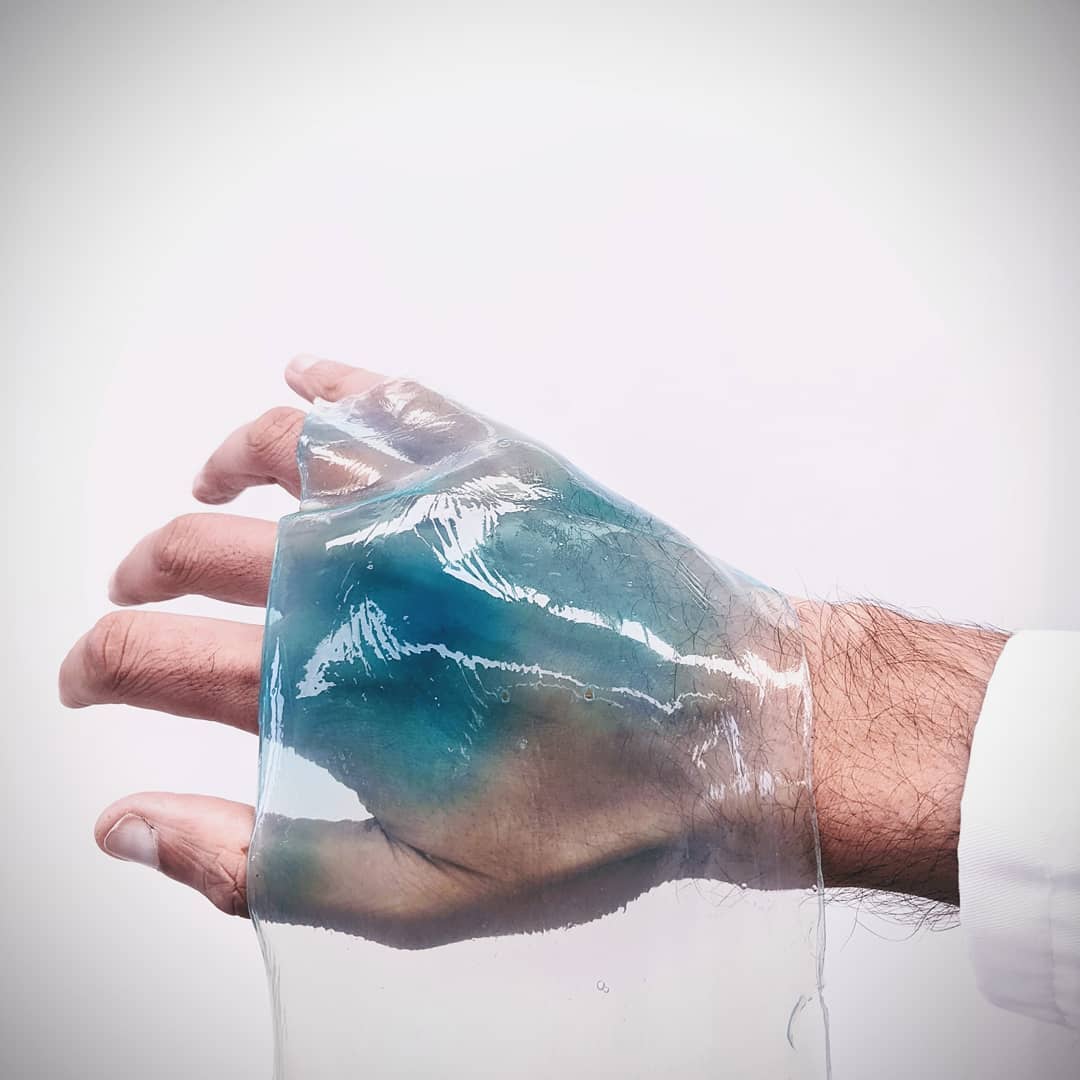
Towards the latter part of our residency the Ginkgo team kindly provided an opportunity for us to make use of a wet-lab at the Centre for Interdisciplinary Research (CRI) in Paris. At CRI we were mentored by Jake Wintermute, a synthetic biologist and friend of Ginkgo. This physical space provided us a new impetus; not only a space in which we could collaborate together but also benefit from and learn about experimentation in the wetlab.
Through our research we uncovered that efforts to thwart and repel other species are now taking on a new dimension, through engineering the skin microbiome itself and the community of organisms that inhabit and indeed form the skin, to actively repel creatures that are deemed unsuitable, unwanted. DARPA is at work on this. A consortium including our residency hosts Ginkgo Bioworks are part of a project known as ReVector, a program looking into how genetically engineering the skin-microbiome can create long-lasting, bacteria-based mosquito repellent. As so often a militaristic agenda pushing the frontiers of human technology.
When we heard this story it immediately triggered a thought. What might happen if we turned this around. What if we rather than repel, we drew other species towards us, using that magical power – a sense of attraction. Might we invite the other species to play with us? Can we refuse to acknowledge the false separations and bifurcations? Is it instead possible to merge bodies, and join forces?
In living systems, attraction is rife, through colour, through sound, and through the chemical signalling of smell. Pheromones are key in this world, simple chemicals that provoke outsized reactions in all manner of beings. Whether you are a Leopard or a Centipede there is a chemical that will work its magic on you. These chemical formulas have evolved with the species to elicit particular reactions that can lead to fear, joy or arousal. Similarly to modifying the skin microbiome, perhaps synthetic biology can be applied to conjure up new signals of attraction.
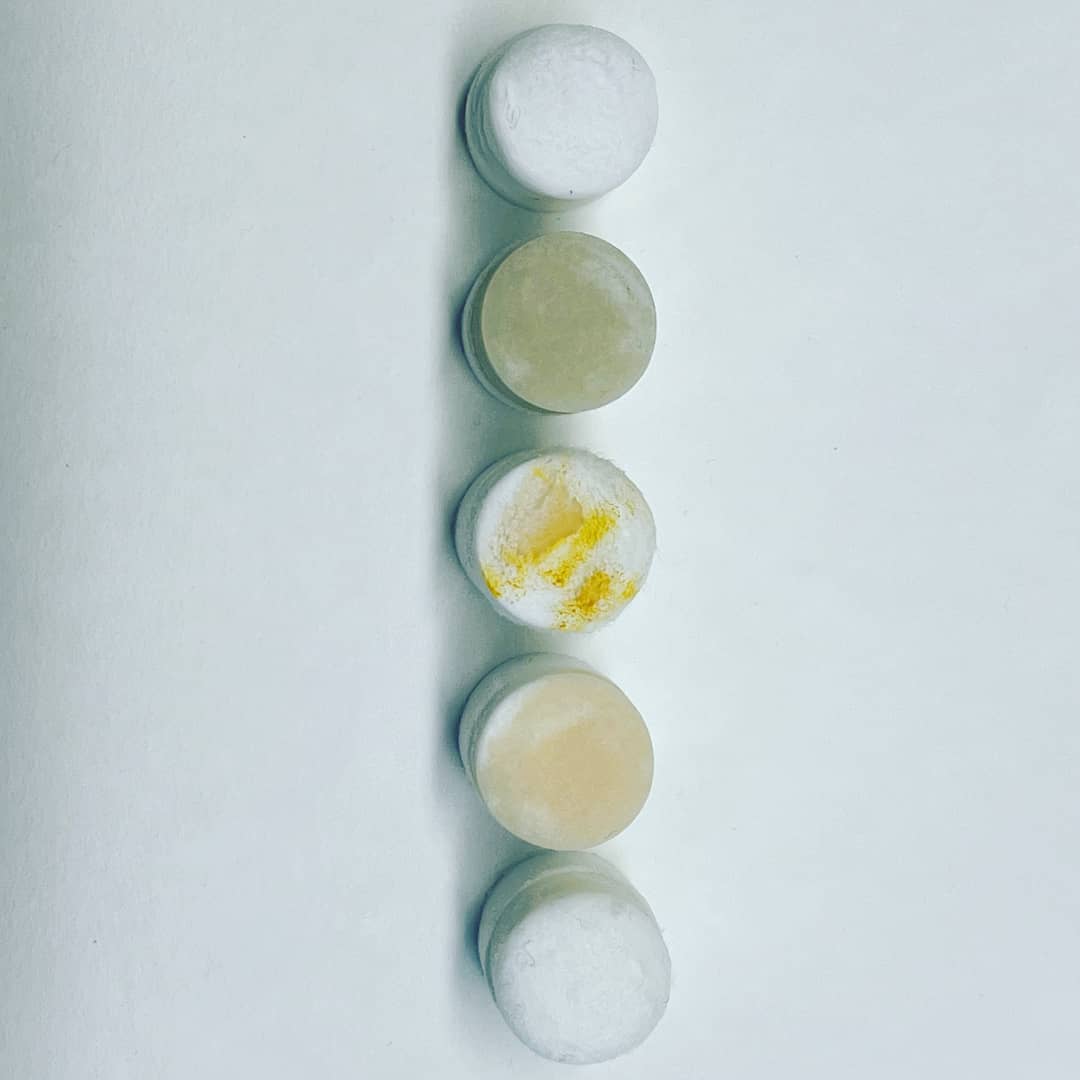
Through our research we were pointed to the complex and downright confusing world of pheromones, discovering gems such as Xt-109_polyphropenel, a pheromone that works wonders on Asian Elephants. It also attracts Monarch Butterflies and hundreds of types of moth. In essence a perfect manifestation of Interspecies Gossip. We decided to explore what might occur when we play with these pheromones to attract other beings, bringing more life and more gossip into the fray. When an organism creates a pheromone. Could we engineer new combinations of pheromones, and imagine creating our own ‘Home-mating systems’. Taking genetically modified organisms, that mate with one another, through a metabolic pathway that might create interesting fragrance variations through mating.
In order to create the attraction we worked with technology that has long since been developed in living systems. Yeasts are one of the first model organisms, and working with the scientists at Ginkgo Bioworks and CRI Paris, we quickly understood that not only could yeasts on their own attract other species due to the whiff of ethanol they emit, but we could modify the yeasts to emit particular pheromones to attract all manner of beings. While we were unable to perform this for real in the lab context, we explored this speculatively working with Jake Wintermute and Sudeep Agarwal, the yeast Viking, who helped us understand the basic principles of what might occur if we were to modify yeast to emit pheromones and then mate them to create new combinations. This thought was intriguing.

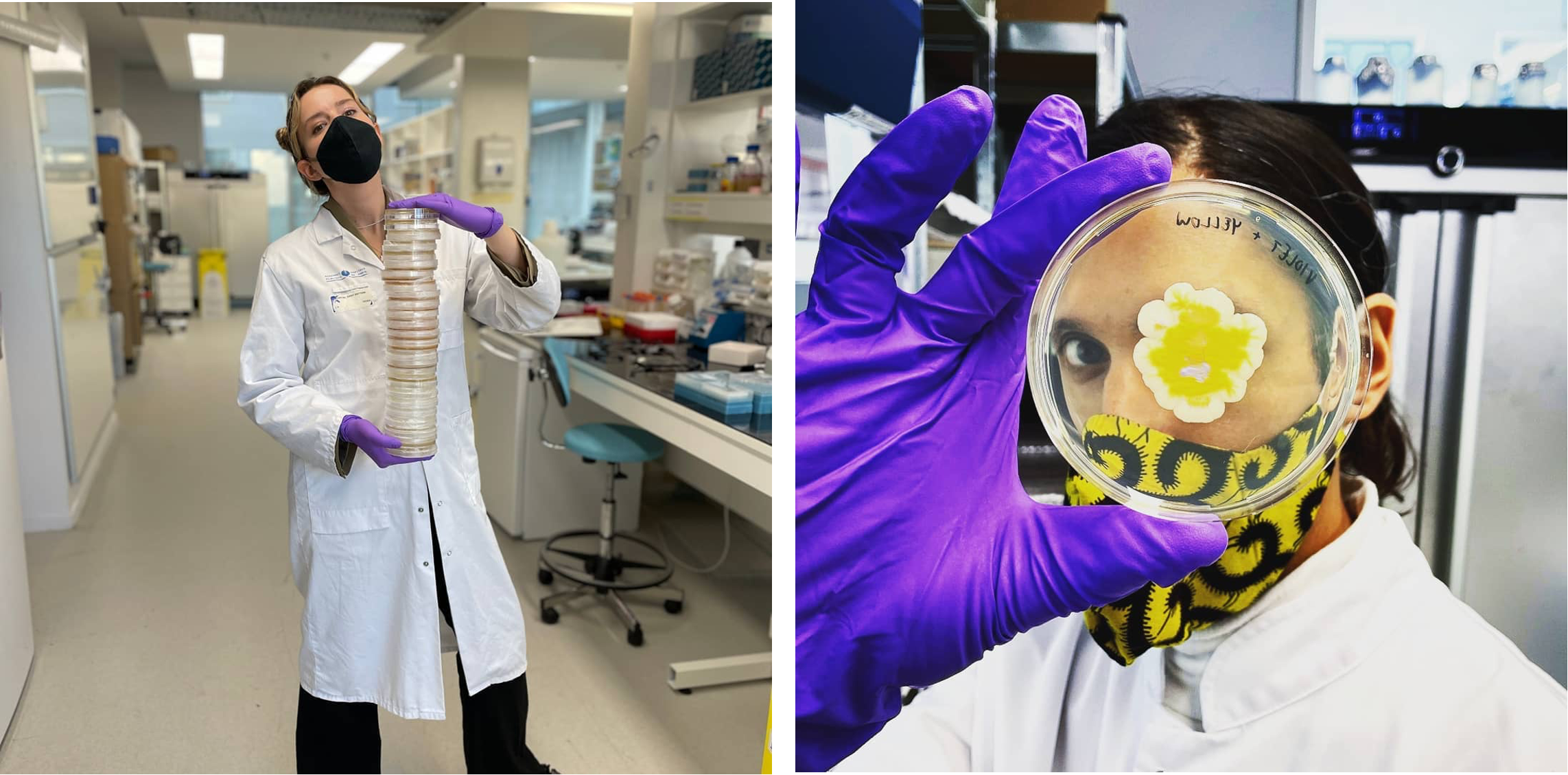
As Sudeep explained to us, imagine if we took 6 genes (a, b, c, d, e, f) that are involved in creating a fragrance. Each gene has a degree of variation, especially genes c and E. We might then take two strains of yeasts, and in yeast(1) we would include genes (a, b, d, f) and in yeast (2) (a, b, d, f). To create interesting variations then, we would add a ‘library’ of genes to yeast(1) e.g. c-1, c-2, c-3 etc. and in yeast(2) similarly we would add e-1, e-2, e-3 etc. On their own neither of the yeast strains produces any fragrance. The magic happens when we mate the two compatible individuals.
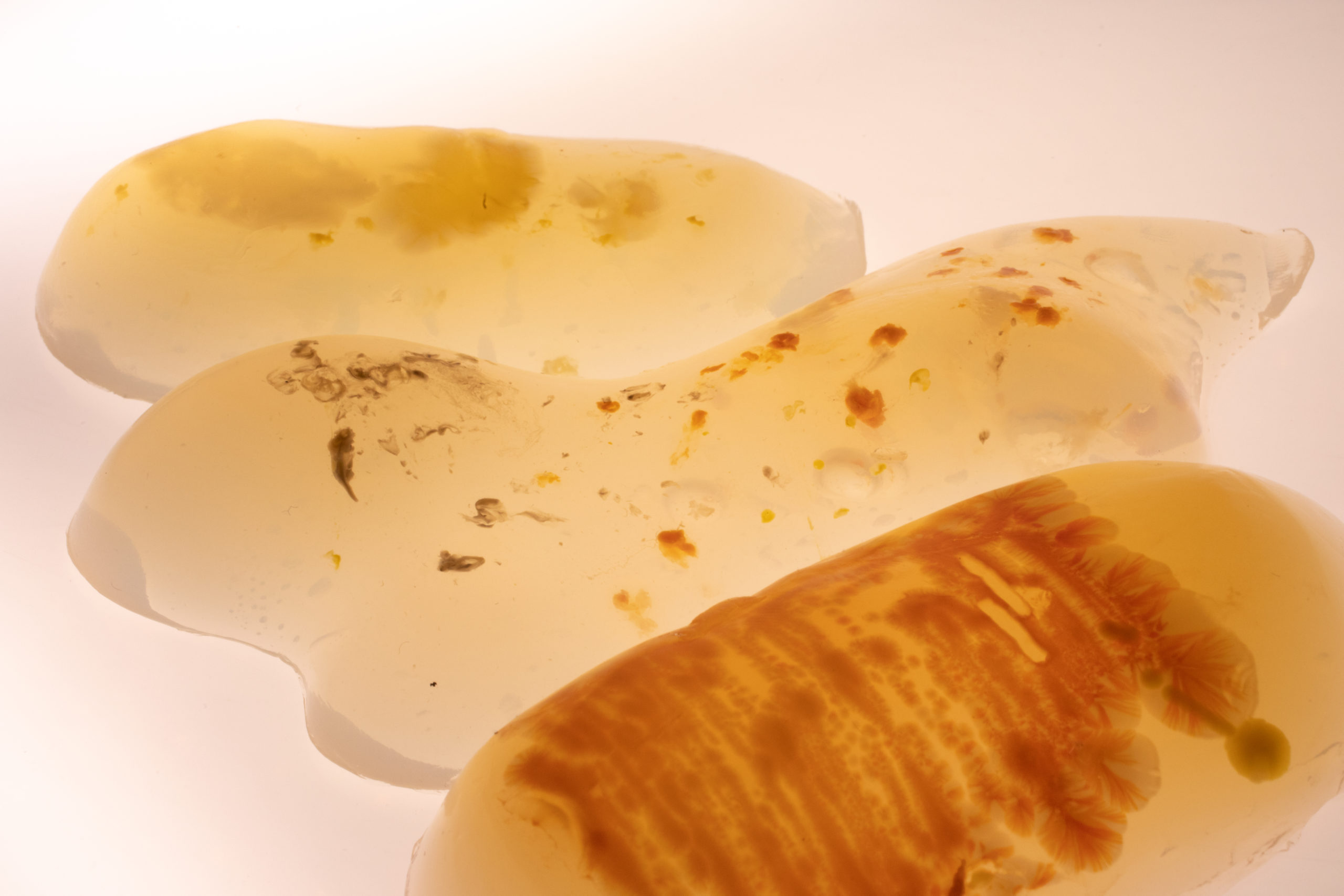

We were aiming at producing objects that could be applied on your skin like soaps, however as mentioned instead of cleaning they would leave an attraction layer on the skin. The objects had to also provide a suitable environment for the yeast. We wanted the objects to relate to the skin, so used the metaphor of ‘Soap’ – imagining a care product that could be applied to skin and would attract other species. Of course we could not create a real soap to house the yeast as the alkaline environment would be unsuitable for their growth. Instead we experimented with various biomaterials, eventually settling on a formula based around agar-agar and amino acid growth media that would provide a nourishing habitat for the yeast to grow.
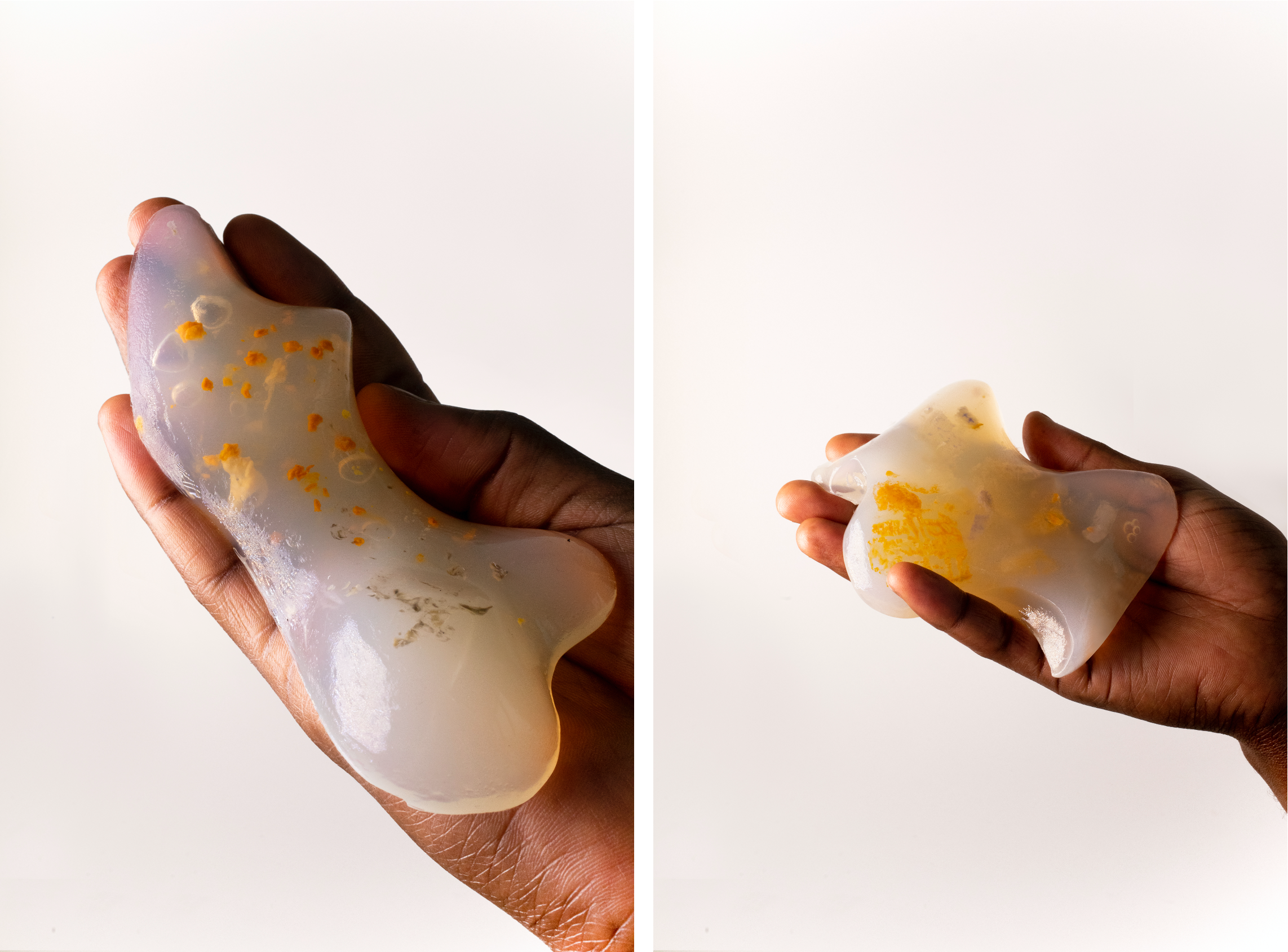
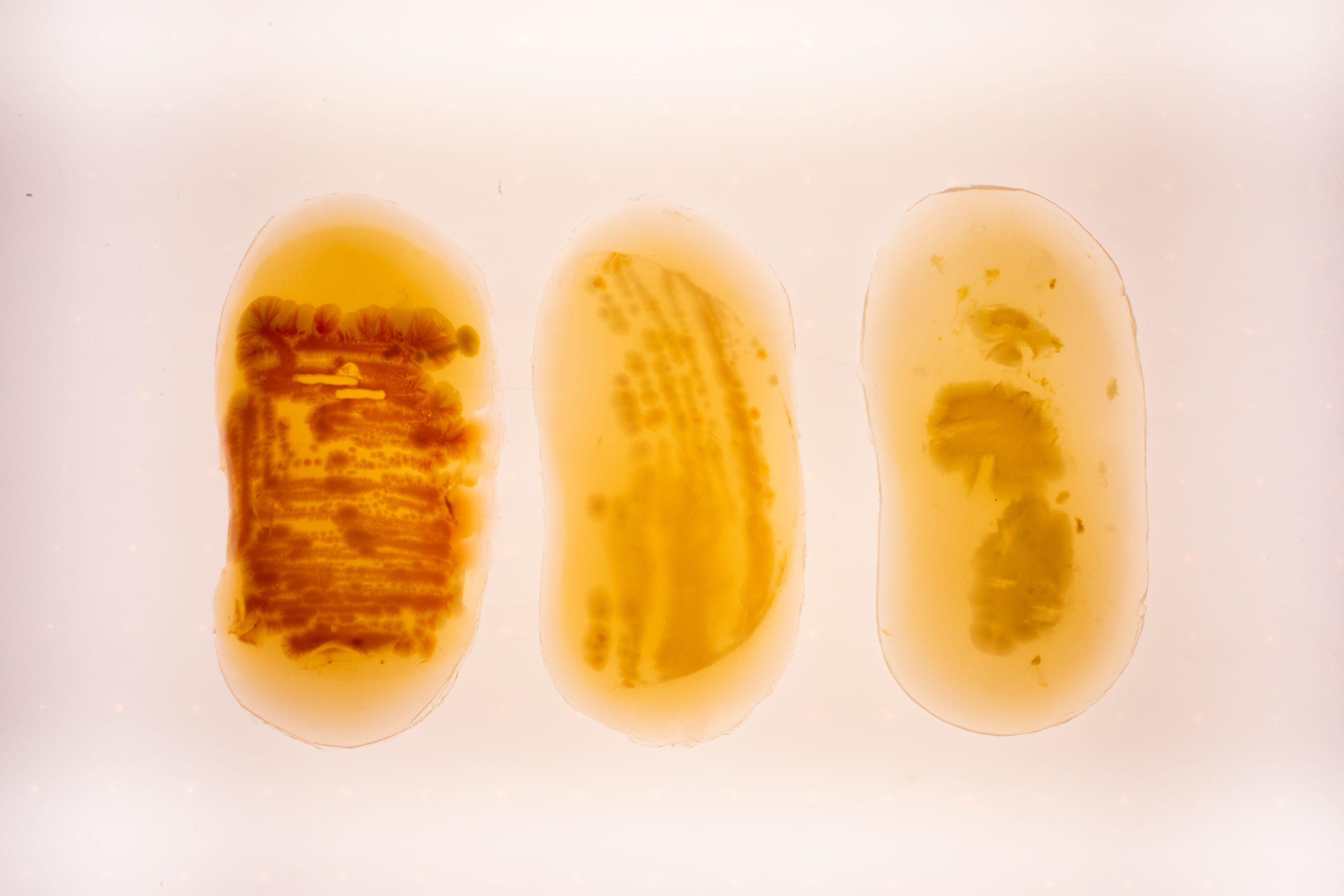
Merging with other species
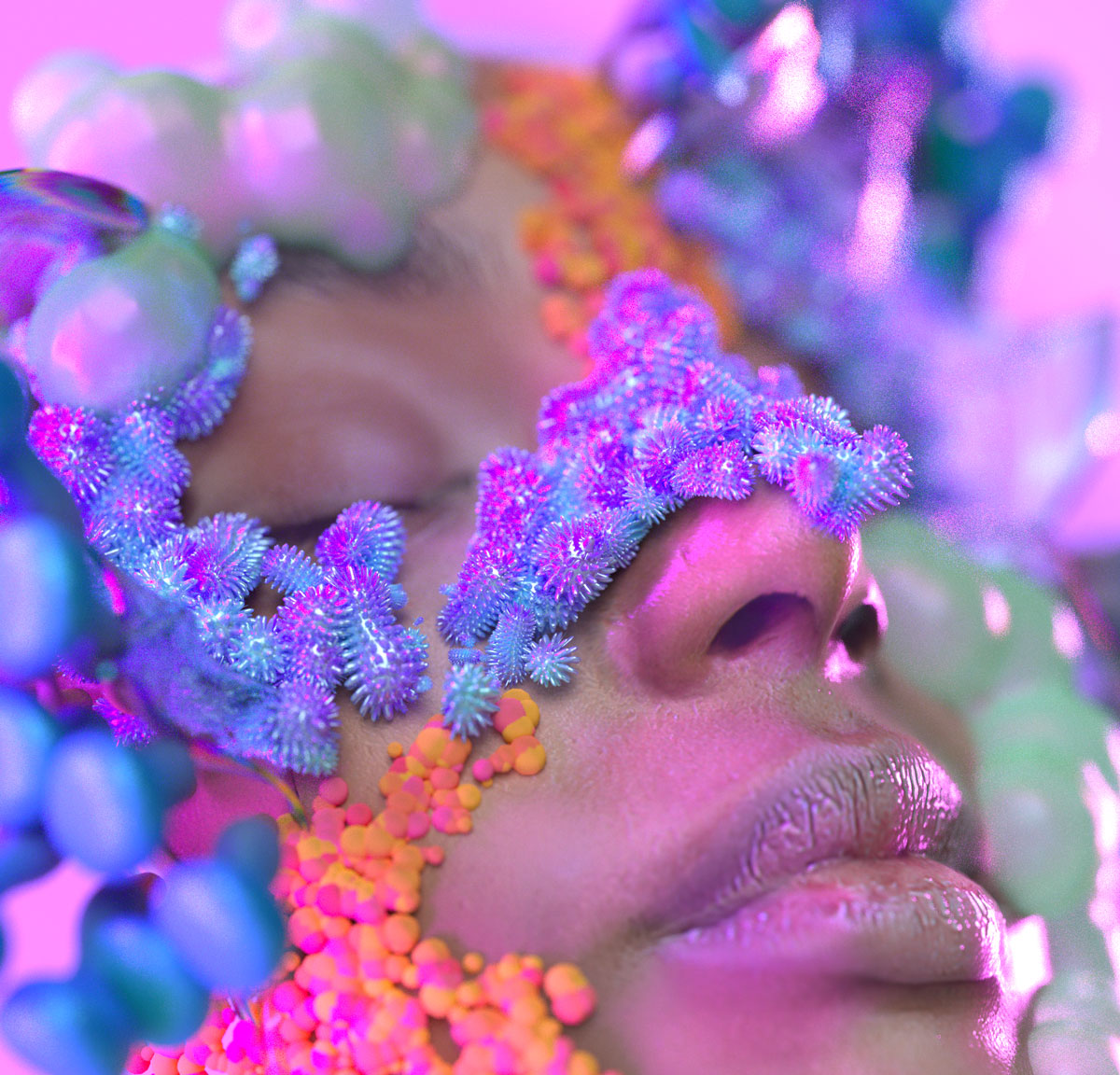
In Chapter 3 – Immersion, we are pointing at the idea of blurring the boundaries between biological and computational, human and nonhuman worlds until they merge. This is the grand finale of the speculative fantasy. The participant has now gone through understanding their home from a new microbial perspective. They dance the rituals at home, almost inviting the stories to emerge. They grow Objects of Attraction, and after adding the attraction layer to their skin, they step into the world which stretches beyond their own body. They are being invited to let themselves get lost and become part of the interspecies gossip.
For this final part, we worked with 3D artist Ines Alpha. We sought to bring our thinking to life through augmented reality and graphics that would appear on the skin, embodying and encapsulating this merge. In the final sequence we see one of the protagonists of the story and various organisms coalesce, culminating in an almost take-over of the human being and human body.
The core aspects of the project are reflected in a deep belief in sharing a welcoming environment and openness. A gratitude towards diversity and otherness that encompasses all beings. Through the lens of other species, particularly microbial species that inhabit the home, Interspecies Gossip explores issues such as migration and borders, the climate crisis, defence, and the pandemic itself. It discusses these subjects in a subtle and non-dogmatic manner, promoting a holistic view of the world, an interconnected system where intertwined planetary issues and relationships are to be explored, not hidden.
At a time where we see the fragility of human society and the manner in which human activity can affect connected ecosystems, the project renders the home as a connected ecosystem. This may be applied to any sense of ‘home’ through a universal sense of exploring the place which one calls home. The project imagines that the results of such explorations would differ greatly depending on geographic location, due to the unique ecosystems, cultural values and types of encounters that each person would bring to their use of the guide.
Throughout the work we see examples of how diversity only brings further richness. The diversity of the nonhuman world in particular is highlighted. We seek to propose models of attracting and co-existing, rather than separation and repelling the other. The non-binary and queer nature of the multispecies and living systems are featured, portraying how other species often demonstrate modes of being that humans do not universally accept, and how living systems are organised to thrive within this melange. The project combines these values and inspirations, to point towards the promotion and necessity of equality and respect amongst people and other beings.
Final Reflections
Clemens Winkler, one of the residency advisors suggested a term for the residency at the outset—a Hybrid Lab experience. On reflection this seems particularly apt, with a blend of a virtual decentralised residency and a lab-based physical format, based across various sites involving partnership with scientists at CRI Paris, the University of Copenhagen, and Ginkgo Bioworks in Boston. The links and network that was built around our research had a highly multidisciplinary spirit, with the arts and science equally well represented. The various fields were able to cooperate and collaborate, private companies and public institutions allowed ideas to flow freely across borders, all contributing to a body of knowledge to share with the general public.
To say that the Ginkgo creative residency came at an interesting moment would be an understatement. The residency was decidedly experimental, with formats that constantly evolved and changed. It was a very important experience for us for multiple reasons. Firstly as designers, being exposed to so much support and guidance to engage with the scientific aspects of research was unique. Taking part in multiple sessions each week with people from diverse backgrounds helped us to constantly scope new aspects of our explorations. Through our creative process we were able to build speculative fantasies on top of the gathered knowledge, creating a feedback loop. It was a creatively challenging experience that taught us how to turn raw data, deep concepts and general models of how nature operates, into stories that comment on contemporary issues such as isolation or the perception of microorganisms from a different perspective.
In the end we see the work as a complementary assemblage of different mediums that together form a fantasy world; from coming up with new modes of deep remote research to blending fiction and nonfiction writing, creating bodily rituals with artists, filming and capturing spontaneous performances, working in the wet lab and engaging with 3D CGI graphics. The residency offered us a space and time to open our minds towards a free exploration of the mediums, issues and themes that felt important to us. This is all too rare in the world and we are truly grateful for the opportunity.
Thank you,
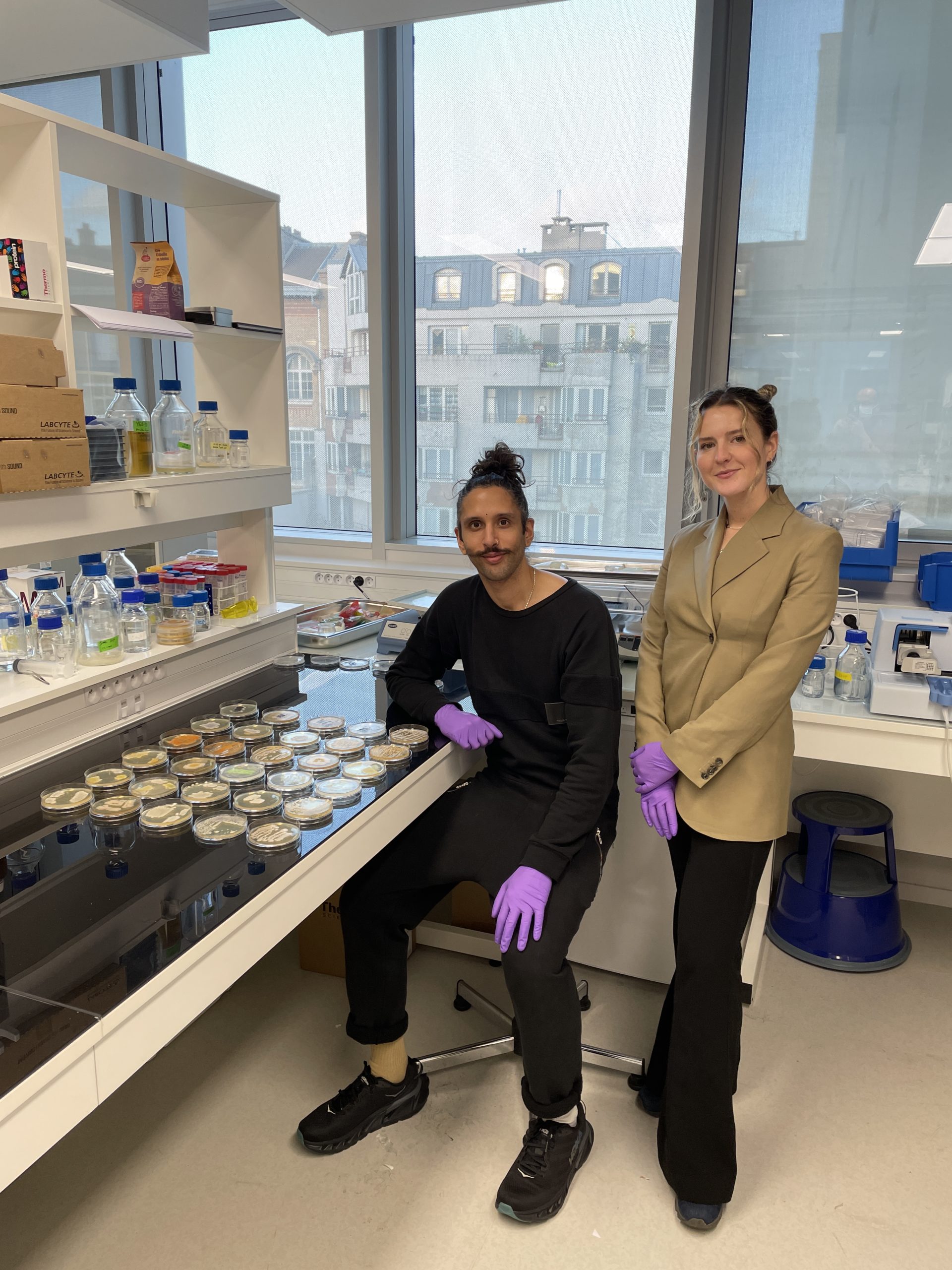
Monika and Cyrus

